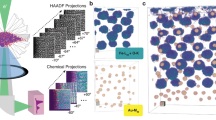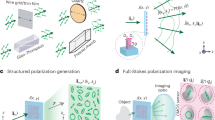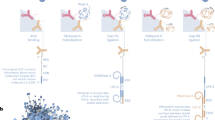Abstract
Existing super-resolution fluorescence microscopes compromise acquisition speed to provide subdiffractive sample information. We report an analog implementation of structured illumination microscopy that enables three-dimensional (3D) super-resolution imaging with a lateral resolution of 145 nm and an axial resolution of 350 nm at acquisition speeds up to 100 Hz. By using optical instead of digital image-processing operations, we removed the need to capture, store and combine multiple camera exposures, increasing data acquisition rates 10- to 100-fold over other super-resolution microscopes and acquiring and displaying super-resolution images in real time. Low excitation intensities allow imaging over hundreds of 2D sections, and combined physical and computational sectioning allow similar depth penetration to spinning-disk confocal microscopy. We demonstrate the capability of our system by imaging fine, rapidly moving structures including motor-driven organelles in human lung fibroblasts and the cytoskeleton of flowing blood cells within developing zebrafish embryos.
This is a preview of subscription content, access via your institution
Access options
Subscribe to this journal
Receive 12 print issues and online access
$259.00 per year
only $21.58 per issue
Buy this article
- Purchase on Springer Link
- Instant access to full article PDF
Prices may be subject to local taxes which are calculated during checkout




Similar content being viewed by others
References
Hell, S.W. Far-field optical nanoscopy. Science 316, 1153–1158 (2007).
Shroff, H., Galbraith, C.G., Galbraith, J.A. & Betzig, E. Live-cell photoactivated localization microscopy of nanoscale adhesion dynamics. Nat. Methods 5, 417–423 (2008).
Jones, S.A., Shim, S.-H., He, J. & Zhuang, X. Fast, three-dimensional super-resolution imaging of live cells. Nat. Methods 8, 499–505 (2011).
Westphal, V. et al. Video-Rate Far-Field Optical Nanoscopy Dissects Synaptic Vesicle Movement. Science 320, 246–249 (2008).
Huang, F. et al. Video-rate nanoscopy using sCMOS camera-specific single-molecule localization algorithms. Nat. Methods 10, 653–658 (2013).
Heintzmann, R. & Cremer, C.G. Laterally modulated excitation microscopy: improvement of resolution by using a diffraction grating. Proc. SPIE 3568, 185–196 (1999).
Gustafsson, M.G.L. Surpassing the lateral resolution limit by a factor of two using structured illumination microscopy. J. Microsc. 198, 82–87 (2000).
Kner, P., Chhun, B.B., Griffis, E.R., Winoto, L. & Gustafsson, M.G.L. Super-resolution video microscopy of live cells by structured illumination. Nat. Methods 6, 339–342 (2009).
Shao, L., Kner, P., Rego, E.H. & Gustafsson, M.G.L. Super-resolution 3D microscopy of live whole cells using structured illumination. Nat. Methods 8, 1044–1046 (2011).
Sheppard, C.J.R. Super-resolution in confocal imaging. Optik (Stuttg.) 80, 53–54 (1988).
Müller, C.B. & Enderlein, J. Image scanning microscopy. Phys. Rev. Lett. 104, 198101 (2010).
Heintzmann, R. & Benedetti, P.A. High-resolution image reconstruction in fluorescence microscopy with patterned excitation. Appl. Opt. 45, 5037–5045 (2006).
York, A.G. et al. Resolution doubling in live, multicellular organisms via multifocal structured illumination microscopy. Nat. Methods 9, 749–754 (2012).
Campbell, C.T., Kolesar, J.E. & Kaufman, B.A. Mitochondrial transcription factor A regulates mitochondrial transcription initiation, DNA packaging, and genome copy number. Biochim. Biophys. Acta 1819, 921–929 (2012).
Baker, M.J., Frazier, A.E., Gulbis, J.M. & Ryan, M.T. Mitochondrial protein-import machinery: correlating structure with function. Trends Cell Biol. 17, 456–464 (2007).
Fiolka, R., Shao, L., Rego, E.H., Davidson, M.W. & Gustafsson, M.G.L. Time-lapse two-color 3D imaging of live cells with doubled resolution using structured illumination. Proc. Natl. Acad. Sci. USA 109, 5311–5315 (2012).
Brown, T.A. et al. Superresolution fluorescence imaging of mitochondrial nucleoids reveals their spatial range, limits, and membrane interaction. Mol. Cell Biol. 31, 4994–5010 (2011).
Wurm, C.A. et al. Nanoscale distribution of mitochondrial import receptor Tom20 is adjusted to cellular conditions and exhibits an inner-cellular gradient. Proc. Natl. Acad. Sci. USA 108, 13546–13551 (2011).
Schmidt, R. et al. Spherical nanosized focal spot unravels the interior of cells. Nat. Methods 5, 539–544 (2008).
Mizuno-Yamasaki, E., Rivera-Molina, F. & Novick, P. GTPase networks in membrane traffic. Annu. Rev. Biochem. 81, 637–659 (2012).
Neuspiel, M. et al. Cargo-selected transport from the mitochondria to peroxisomes is mediated by vesicular carriers. Curr. Biol. 18, 102–108 (2008).
Yonekawa, S. et al. Sec16B is involved in the endoplasmic reticulum export of the peroxisomal membrane biogenesis factor peroxin 16 (Pex16) in mammalian cells. Proc. Natl. Acad. Sci. USA 108, 12746–12751 (2011).
Woźniak, M.J. et al. Role of kinesin-1 and cytoplasmic dynein in endoplasmic reticulum movement in VERO cells. J. Cell Sci. 122, 1979–1989 (2009).
Grotjohann, T. et al. rsEGFP2 enables fast RESOLFT nanoscopy of living cells. eLIFE 1, e00248 (2012).
Sundd, P. et al. 'Slings' enable neutrophil rolling at high shear. Nature 488, 399–403 (2012).
Botcherby, E.J., Juskaitis, R., Booth, M.J. & Wilson, T. Aberration-free optical refocusing in high numerical aperture microscopy. Opt. Lett. 32, 2007–2009 (2007).
Brakenhoff, G.J. & Visscher, K. Confocal imaging with bilateral scanning and array detectors. J. Microsc. 165, 139–146 (1992).
Rego, E.H. et al. Nonlinear structured-illumination microscopy with a photoswitchable protein reveals cellular structures at 50-nm resolution. Proc. Natl. Acad. Sci. USA 109, E135–E143 (2012).
Gustafsson, M.G.L. Nonlinear structured-illumination microscopy: wide-field fluorescence imaging with theoretically unlimited resolution. Proc. Natl. Acad. Sci. USA 102, 13081–13086 (2005).
Chmyrov, A. et al. Nanoscopy with more than 100,000 'doughnuts'. Nat. Methods 10, 737–740 (2013).
Grotjohann, T. et al. Diffraction-unlimited all-optical imaging and writing with a photochromic GFP. Nature 478, 204–208 (2011).
Oliphant, T.E. Python for scientific computing. Comput. Sci. Eng. 9, 10–20 (2007).
Richardson, W.H. Bayesian-based iterative method of image restoration. J. Opt. Soc. Am. 62, 55–59 (1972).
Lucy, L.B. An iterative technique for the rectification of observed distributions. Astron. J. 79, 745–754 (1974).
Goedhart, J. et al. Structure-guided evolution of cyan fluorescent proteins towards a quantum yield of 93%. Nat. Commun. 3, 751 (2012).
Bhattacharyya, D. & Glick, B.S. Two mammalian Sec16 homologues have nonredundant functions in endoplasmic reticulum (ER) export and transitional ER organization. Mol. Biol. Cell 18, 839–849 (2007).
Acknowledgements
We thank G. Patterson for encouragement and the use of his cell culture facilities, L. Maldonado-Baez (US National Heart, Lung, and Blood Institute) for the mCherry-tagged Rab8A plasmid, C. Combs for lending us his objective lenses, S. Parekh for useful discussions and for help in sample preparation, E. Tyler and A. Hoofring for help with illustrations and Y. Wu for help with Huygens deconvolution software. This work was supported by the Intramural Research Programs of the US National Institute of Biomedical Imaging and Bioengineering (to A.G.Y., P.W. and H.S.); the National Institute of Diabetes and Digestive and Kidney Diseases (to P.C.); the National Heart, Lung, and Blood Institute (to R.S.F.) and the National Institute of Child Health and Human Development (to D.D.N., J.H. and A.C.).
Author information
Authors and Affiliations
Contributions
A.G.Y. and H.S. conceived idea and designed optical system. A.G.Y. built the optical system, designed and implemented data acquisition software and performed simulations. A.G.Y., P.C., D.D.N., J.H., R.S.F. and H.S. acquired data. P.C., D.D.N., R.S.F. and A.C. provided guidance on biological experiments. P.C., D.D.N., J.H., P.W. and R.S.F. prepared samples. P.C., D.D.N., J.H., R.S.F. and A.C. provided biological reagents. All authors analyzed data. A.G.Y., P.C. and H.S. wrote the paper with input from all authors. H.S. supervised research.
Corresponding author
Ethics declarations
Competing interests
The authors declare no competing financial interests.
Supplementary information
Supplementary Text and Figures
Supplementary Figures 1–13, Supplementary Table 1 and Supplementary Note (PDF 2021 kb)
Dual-color instant SIM imaging of mitochondria with Tom20-mCherry (red) and TFAM-GFP (green).
Dual-color volumes (12 imaging planes/volume) were acquired in 1.2 s and imaged every 2.5 s. XY maximum intensity projections are shown. See also Fig. 2. (AVI 1358 kb)
Dual-color spinning disk confocal imaging of Tom20-mCherry (red) and TFAM-GFP (green).
Dual-color volumes (12 imaging planes/volume) were acquired in 12 s and imaged every 12 s. XY maximum intensity projections are shown. Data are deconvolved. See also Fig. 2. (AVI 792 kb)
Dual-color line-scanning confocal imaging of Tom20-mCherry (red) and TFAM-GFP (green).
Dual-color volumes (12 imaging planes/volume) were acquired in 1.2 s and imaged every 5 s. XY maximum intensity projections are shown. Data are deconvolved. See also Fig. 2. (AVI 538 kb)
Instant SIM imaging of GFP-HRAS over 100 volumes.
Two imaging planes at indicated axial distance from coverslip are shown. Volumes (12 imaging planes) were acquired in 0.6 s and imaged every 2 s. (AVI 16979 kb)
Dual-color instant SIM imaging of GFP-HRAS (green) and mCherry-Rab (red) over 60 volumes.
Two imaging planes at indicated axial distance from coverslip are shown. Volumes (12 imaging planes) were acquired in 0.7 s and imaged every 5 s. (AVI 31816 kb)
Dual-color instant SIM imaging of mitochondria with Tom20-mCherry (red) and peroxisomes with PEX-GFP (green) over 60 volumes.
Dual-color volumes (12 imaging planes/volume) were acquired in 1.2 s and imaged every 7.5 s. xy maximum intensity projections are shown. (AVI 5221 kb)
Higher magnification view of Tom20-mCherry and PEX-GFP.
Interactions between mitochondrial entities could be either in a "kiss and run" or prolonged mode (small Tom20-Cherry and PEX-GFP positive densities). (AVI 529 kb)
Dual-color instant SIM imaging of GFP-SEC16B (green) and PEX-mCherry (red).
Dual-color volumes (12 imaging planes/volume) were acquired in 1.2 s and imaged every 5.5 s. xy maximum-intensity projections are shown. (AVI 4020 kb)
Higher magnification view of GFP-SEC16B (green) and PEX-mCherry (red) over 60 volumes.
Note interactions amongst peroxisomes with fusion events, but also between peroxisomes and lamellar ER extensions, likely depicting transfer of material from the endoplasmic reticulum. (AVI 146 kb)
Instant SIM imaging of the endoplasmic reticulum at 100 Hz over 200 time points.
The ER is labeled with GFP-Sec61. See also Fig. 3b. (AVI 1882 kb)
Instant SIM imaging of microtubules inside flowing blood cells in 3 day old zebrafish embryo, over 100 time points.
Imaging was performed at 37 Hz. See also Fig. 4. (AVI 14005 kb)
Supplementary Software
Hardware control and deconvolution scripts for instant SIMFor documentation, and the most recent versions, see http://code.google.com/p/msim (ZIP 27 kb)
Rights and permissions
About this article
Cite this article
York, A., Chandris, P., Nogare, D. et al. Instant super-resolution imaging in live cells and embryos via analog image processing. Nat Methods 10, 1122–1126 (2013). https://doi.org/10.1038/nmeth.2687
Received:
Accepted:
Published:
Issue Date:
DOI: https://doi.org/10.1038/nmeth.2687
This article is cited by
-
In situ architecture of Opa1-dependent mitochondrial cristae remodeling
The EMBO Journal (2024)
-
Superresolution structured illumination microscopy reconstruction algorithms: a review
Light: Science & Applications (2023)
-
Three-dimensional structured illumination microscopy with enhanced axial resolution
Nature Biotechnology (2023)
-
100 Hz ROCS microscopy correlated with fluorescence reveals cellular dynamics on different spatiotemporal scales
Nature Communications (2022)
-
Incorporating the image formation process into deep learning improves network performance
Nature Methods (2022)



